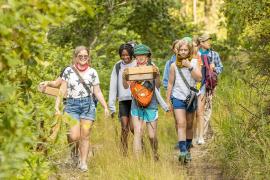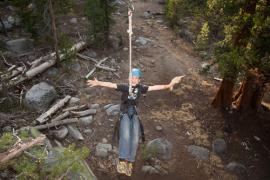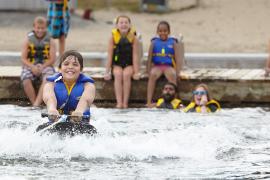Hello Camp Evaluators!
If you are new to the Research 360 blog, you’ll see that our posts fall into three main categories: camp evaluation tips and tricks, creating powerful charts and reports, and updates on ACA’s 5-Year Impact Study. Today’s post falls into this last category, but stay with us over the next few weeks, as we have new topics planned in the other two categories.
We introduced ACA’s 5-Year Impact Study several months ago, describing its purpose and the advisory committee responsible for ensuring its credibility and relevance for camp professionals.
Since then, the ACA research team and the University of Utah project team have been busy building project partnerships and launching the first phase of the study. Here is what we’ve learned so far.
But first, here is a visual overview of the study (1-page download to share with your staff and stakeholders):
Lesson No. 1: Camp People Get Research
ACA’s Board of Directors named research as one of the association’s strategic directions because they knew research was critical for camps to thrive and expand their reach in the future. What we’ve learned since launching this project is that camp professionals get research now. There were over fifteen research-related sessions at the 2017 ACA National Conference, and attendance averaged thirty-five participants per session. Not only did camp people show up, but they engaged and demonstrated a keen understanding of the importance of camp research. Sharing the Impact Study with the camp community has made it clear that camp people understand and are ready for credible research that will help them advocate for the good work they do.
Lesson No. 2: Random Sampling Is Complicated
The key to credible research is the way people are recruited to participate. Random sampling means that participants are chosen without bias from a pool of all possible participants — in this case, camps are chosen from a pool of all possible camps. But, we are learning, there are vast differences between ACA-accredited camps, and it is critical the Impact Study represents as many different types of camp as possible. To do this, the research team decided to use what’s called stratified random sampling, which means that camps are selected randomly from “buckets” containing camps of similar characteristics — day camps, overnight camps, faith-based camps, medically focused camps, agency-affiliated camps, nonprofit camps and independent for-profit camps. It is also important we sample evenly by region, which means that random sampling just got a lot more complicated.
Lesson No. 3: Research Connects
But despite the vast and important differences between camps, we have also learned that the Impact Study will be an important source of connection. The study will connect individual camps by providing evidence of the camp experience — the tie that binds camps across location, size, and focus. We’ve also learned the power of research to connect the camp industry to non-camp organizations, such as education and health-related organizations. By connecting within and beyond the camp industry, research is clearly a powerful source of conversation and collaboration.
We have learned a lot, and we have much more to learn over the next five years. Follow along in the Research 360 blog, and look for preliminary findings at next year’s ACA National Conference. In the meantime, keep reading as we share project updates and much more to help you use camp research and evaluate your camp programs.
Thanks to our research partner, Redwoods.
Additional thanks goes to our research supporter, Chaco.
The views and opinions expressed by contributors are their own and do not necessarily reflect the views of the American Camp Association or ACA employees.






